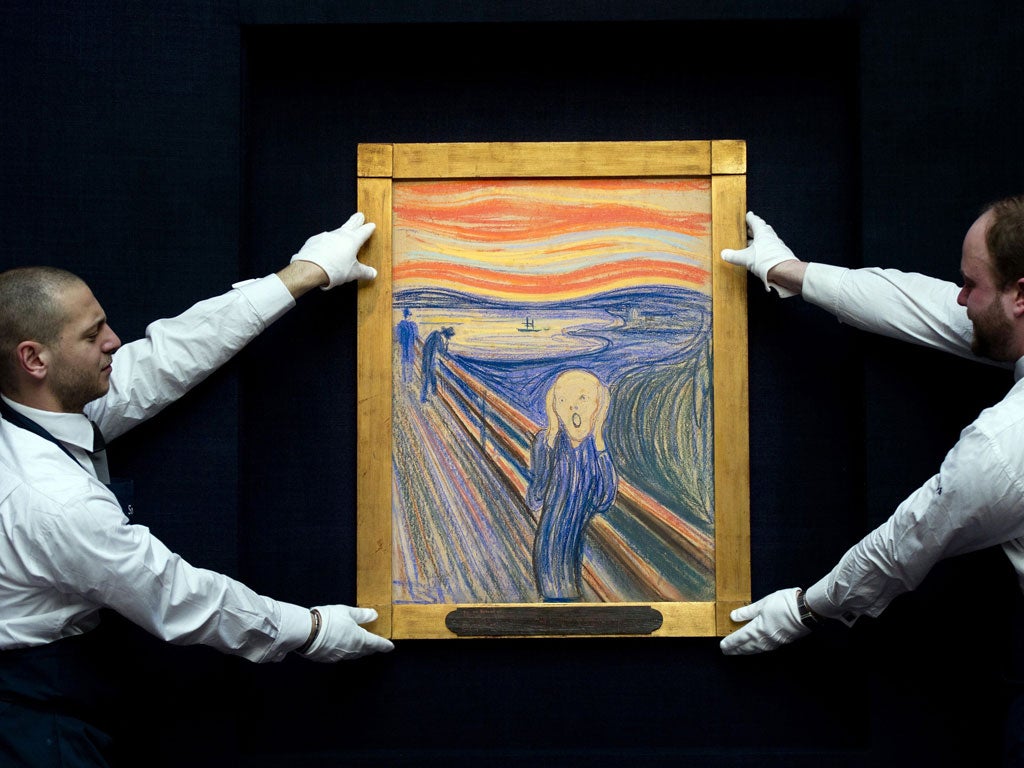The secret of Edvard Munch's record-breaking Scream
Meet Mr Black. The new owner of The Scream. By David Usborne

Your support helps us to tell the story
From reproductive rights to climate change to Big Tech, The Independent is on the ground when the story is developing. Whether it's investigating the financials of Elon Musk's pro-Trump PAC or producing our latest documentary, 'The A Word', which shines a light on the American women fighting for reproductive rights, we know how important it is to parse out the facts from the messaging.
At such a critical moment in US history, we need reporters on the ground. Your donation allows us to keep sending journalists to speak to both sides of the story.
The Independent is trusted by Americans across the entire political spectrum. And unlike many other quality news outlets, we choose not to lock Americans out of our reporting and analysis with paywalls. We believe quality journalism should be available to everyone, paid for by those who can afford it.
Your support makes all the difference.The gossip in the lobby of Sotheby's on the upper east side of Manhattan was all over the place that evening in May when Edvard Munch's The Scream went under the gavel for $119.9m, a record for any art work sold at auction. Did the state of Qatar buy it, or Bill Gates maybe? Surely it was a Russian billionaire or perhaps one the nouveau very riche of China. What most people agreed was this: it was unlikely any art museum could have plunked down so mighty a sum.
At the time no one was saying, and it seemed reasonable to assume the identity of the telephone bidder would remain a secret. It is often the way. And when they bid by phone, they almost always have someone else on the line.
The Scream had been put up for sale by a Norwegian shipping heir, Petter Osen, who planned to build a hotel and a museum to cater to Munch enthusiasts. The man on the phone acting for the buyer was Charles Moffett, Sotheby's executive vice president.
Now we learn that the man with the money and the appetite for the painting – actually a pastel – was, at least according to The Wall Street Journal, Leon Black, a New York financier who heads up the powerful investment firm, Apollo Global Management. Several people close to him confirmed the purchase, the paper affirmed. Mr Black and two partners formed Apollo in 1990. The company manages $105bn in assets and went public in March last year, an event that gave Mr Black even more spending money than he already had.
Probably the speculation should have turned to the Titans of finance in the first place. It isn't just that they have spare cash or that some are more than casual enthusiasts. Mr Black, should you ever be invited to his Park Avenue home, may show you works he already owns by Turner, Van Gogh, Cézanne and Raphael among others. Also involved here is the growing popularity of art as an investment instrument for the very wealthy and for institutions also, which has put the octane not just in auction houses like Sotheby's and Christie's but also into the ever more lively global circuit of art fairs, notably Art Basel, which three times a year draws crowds of gallerists, collectors to Miami, Basel and Hong Kong.
"It's not just fashionable; it really makes a lot of sense," Bob Rice, managing partner at Tangent Capital Partners LLC, an investment banking firm, explained recently. "Art is definitely becoming more of a bona fide asset class than it was even five years ago, when people would have raised an eyebrow about that claim."
Another financier who stands out for his magpie habits in the canvas department is Steven Cohen, the Connecticut-based hedge fund manager. Reported to earn $1bn annually, he has a Munch in his famously extensive collection and in 2010 paid $35.4m at Sotheby's for Andy Warhol's iconic Coca-Cola portrait. Some wondered if he had been the buyer of The Scream.
That it turns out to be Mr Black is by no means anti-climactic. It will boost confidence in the art market globally and doubtless lead us to other nights of auction room drama and new purchase-price records. He and his wife, Debra, a theatre producer, are considered among the most serious collectors in the business with a portfolio of works estimated to be worth about $750m.
"I wish museum directors knew as much about art as Leon Black does," Richard Feigen, an Old Masters dealer, who has sold him art in the past, told the Journal. "Nobody has his wingspan."
Join our commenting forum
Join thought-provoking conversations, follow other Independent readers and see their replies
Comments